Missouri Leadership Academy Class 12 Explores Employee Satisfaction Data
 Congratulations to Ashley Golden, Taylor Hagenhoff and Kyle Groll, who have graduated with Class 12 of the Missouri Leadership Academy, a cross-department leadership development program in which participants focus on leading themselves, leading others and leading change within state government.
Class 12 capstone teams examined Quarterly Pulse Survey (QPS) data to find ways to improve state team members' work experience, exploring competitive insights, role clarity, career opportunities, talent development, supportive leadership, and rewards and recognition.
The Corrections Way Coordinator Ashley Golden started her corrections career as a senior office support assistant before being promoted to senior staff development training specialist and then taking her current role with The Corrections Way, a role in which she drives continuous improvement and cultural transformation.
Legislative Liaison Taylor Hagenhoff joined the Missouri Department of Corrections in 2018 as a correctional case manager at Moberly Correctional Center (MCC) and was promoted to functional unit manager in 2021. She became nursery program manager in 2022 and legislative liaison in 2024.
Tipton Correctional Center (TCC) Deputy Warden Kyle Groll, a corrections staff member since 2001, has served as a correctional officer, corrections classification assistant, probation and parole assistant, corrections case manager, functional unit manager and assistant warden at sites throughout mid-Missouri.
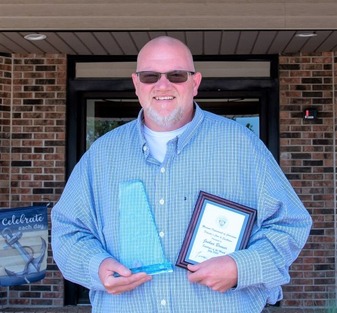
Joshua Brower, an employee health nurse at Eastern Reception, Diagnostic & Correctional Center (ERDCC), is the department employee of the month for July 2024.
Brower’s kindness and compassion are boundless.
When a fellow staff member was grappling with the emotional, physical and logistical complications of caring for a special-needs adult child nearing the end of her life, Brower stepped in to offer care and support. He researched resources to help fill in the gaps when cuts in supplemental care left the coworker without sufficient time to run errands and tend to basic needs while also working a full-time job. When the patient was hospitalized for several weeks, Brower checked in with his teammate regularly to offer emotional support and referrals. Ultimately, when the patient entered palliative care, Brower and his wife visited the coworker’s home to provide supplies and show her how to care for daughter and prevent bed sores and other complications. The couple continued to provide services and advice throughout the patient’s life.
Nurse Brower’s warmth and generosity epitomize corrections values and have made an unforgettable difference in the life of a teammate.
|
Transition Center Team Honored for Heroic Act
 While performing a wellness check at the Transition Center of Kansas City (TCKC), then-Correctional Officer I Marcus Arganbright and Sgt. Dustin Buck found a resident unresponsive in a chair. They called for help. Lt. Alexander Clausen, Lt. Thomas Albertson and Nurse Elisa Crank arrived on the scene and initiated lifesaving measures, including performing CPR and using a defibrillator, while waiting for an ambulance. Kansas City Fire Department paramedics arrived, and the team continued to render assistance until a pulse was detected. After several months in intensive care, the resident regained consciousness and is alive today largely because of the heroic actions of corrections staff. For taking extraordinary actions to save the life of another person, Sgt. Arganbright, Sgt. Buck, Lt. Clausen, Lt. Albertson and Nurse Crank have been honored with the department’s Lifesaver Award.
Officer Recognized for Rescuing Resident
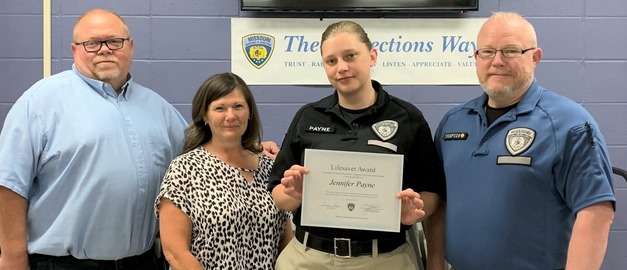 Western Reception, Diagnostic and Correctional Center (WRDCC) Correctional Officer I Jennifer Payne has earned the Missouri Department of Corrections Lifesaver Award. Payne was recognized for her her swift action and skilled intervention when she discovered a resident unresponsive. She called a medical emergency and began CPR, saving the resident's life.
Training Readies Teams to Make Corrections Safer
 Congratulations to the nearly three dozen corrections staff members who recently completed Crisis Intervention Team (CIT) training. The 40-hour course empowers correctional staff to identify behavioral health crises, use advanced communication and de-escalation techniques, and learn strategies and tactics for managing challenging behavioral situations. CIT training fosters personal and professional growth, positively affects facilities and communities, and gives participants a chance to network with colleagues and behavioral health experts. Use of CIT techniques has been shown to reduce assaults and uses of force in facilities.
Crisis Intervention Team Coordinator Sarah Jensen and training team members Terrie Martin, Carl Lewis and Zach Crothers organized this summer's training. Speakers included Moberly Correctional Center Major Marcus Groza, Mental Health Services Assistant Division Director Scott O’Kelley and Regional Behavioral Health Specialist Kristin Farnsworth.
The Corrections Way Welcomes New Adjuncts
 This summer, 11 corrections staff members have become certified as adjunct trainers in The Corrections Way (TCW). The group took part in TCW boot camp, participated in coaching sessions with training specialists, and completed a four-hour evaluation during session, during which they demonstrated their personal commitment to TCW principles and applied months of feedback to their facilitation of sessions.
The adjunct trainers are TCW subject-matter experts who have been certified to facilitate the four-hour frontline staff training and the eight-hour supervisor training. Level-one adjuncts facilitate the four-hour course, while level-two adjuncts facilitate both the four- and eight-hour courses. Adjuncts help develop future adjunct trainers and facilitate boot camps. They also are equipped to facilitate one-hour TCW workshops or assist ambassadors.
Welcome to Kassi Richmond, Amanda Spears, Colton Moots, Michelle Sewell, Rhonda Tarrants, Sarah Morris, Dan Rodriguez, Greg Smith, Kimberly Kavanaugh, Jennifer Dooley and Ronda Capps.
Trainers Recognized for Collaborative Accomplishments
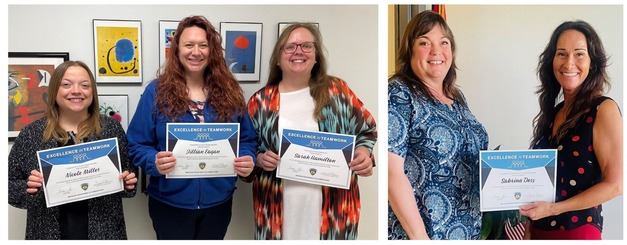 Members of the training team recently were recognized with the Excellence in Teamwork award. Sabrina Doss, Nicole Miller, Jillian Eagan and Sarah Hamilton of the Curriculum Design Unit have been honored for their work in restructuring curriculum content to fit the innovative approach to training at our new Academy for Excellence in Corrections in Cameron. This team researched other state correctional practices, visited multiple correctional sites and met with Missouri State Highway Patrol staff — and ultimately wrote more than 20 new training courses while updating or modifying 20 others in just nine months.
Vince Rost Now Overseeing Investigations

Vince Rost has been named assistant director for investigations in the Division of Adult Institutions, effective July 15, 2024.
In this role, Rost oversees the division's new investigations unit.
Rost joined the Missouri Department of Corrections in 2013 as a probation and parole officer. He has since served as unit supervisor and district administrator in the Division of Probation and Parole and as director of the Office of Professional Standards in Central Office.
Rost holds a bachelor's degree in history and political science and a master's degree in human resource development. Before joining the department, he served in the U.S. Navy for 20 years, in roles including trainer, gun technician and Military Police officer.
|
National Public Radio Affiliate Station Covers Corrections Innovations
 KBIA, Columbia's NPR-affiliate public radio station, recently has broadcast stories about groundbreaking programs our teams are facilitating in Missouri prisons. Take a look.
Statewide Learning Management System Launches
 Our new staff-training learning management system, MOVERS Learn, is live! A replacement for the DOC-GPS system, MOVERS Learn is part of a larger, statewide, multi-department project that consolidates management of multiple processes (personnel, procurement, financials, etc.) for all state agencies in one system. Training for Fiscal Year 25, which began July 1, 2024, will be managed through MOVERS Learn.
Getting Started

- Open MOVERS Learn in a browser by visiting tinyurl.com/MOVERSLearn or clicking the link on the intranet.
-
IMPORTANT: On the login page, click on "Company Single Sign-on," and you'll be directed to the State of Missouri Employee Login single-sign-on page. Do not attempt to sign on using the User ID box on the Oracle Applications Cloud page.
- Click on "Learning" to access your training.
- At the bottom of the page, select "Search" to find your mandatory training requirements, based on job type and specialization.
Need help? Contact gpshelp@doc.mo.gov.
|
The staff training and development team also has created a new annual mandatory training form to help staff determine mandatory training requirements for FY25. Select the appropriate categories for your job type — custody or non-custody, institutional or non-institutional, frontline or supervisor — to view a list of required courses for the new fiscal year. Download the form »
Department implements full-body scanners for staff and visitors
It’s no secret that the methods for sneaking dangerous contraband into corrections facilities are creative and everchanging. Children’s toys, religious books, legal documents, trash, food and the human body are but a handful of places smugglers have hidden items over the years.
For that reason, administrators at the Department of Corrections are constantly seeking the latest technology and strategies to make the environment safer for staff and residents.
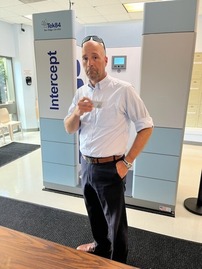
Effective Aug. 1, 2024, MODOC is using body scanners for staff, visitors, vendors, contractors and volunteers entering adult institutions. The Intercept full-body scanner — manufactured by Tek 84 and already in use for the resident population — are used in conjunction with walk-through metal detectors, hand-held metal detectors and X-ray baggage scanners to keep out weapons, drugs and other prohibited items.
“We’ve always done random staff searches and pat-downs looking for contraband in pockets and elsewhere, but the logistics require a lot of manpower and a lot of time,” said Myles Strid, director of the Division of Adult institutions, “whereas a body scanner gathers information in a few seconds.”
It works like this: Every staff member’s name and employee ID number is entered into the system and stored before body scanner use begins. Each employee, contracted staff member or volunteer entering a front entry search point pushes a random search selector, which determines who is subject to a full-body scan. The person being scanned stands inside the Intercept and remains motionless as the operator initiates a four-second scan. The image displays on the workstation monitor, and the operator inspects the image for concealed objects.
|
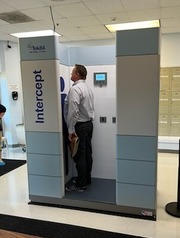
“Being able to see inside the whole body, as opposed to just what’s on the surface, is the key,” said Security Specialist Victor Clevenger. “They also act as a psychological deterrent, discouraging people from bringing in contraband. Staff obviously understand that there have been drug issues within the institutions, and that this is another tool that’s going to help them make the overall environment safer.”
The Intercept machine itself is also safe. It operates as a general-use system under guidelines defined by ANSI/HPS N43.17 (American National Standards Institute / Health Physics Society). Intercept acquires images by using an extremely low level of transmission X-ray.
According to the U.S. Food and Drug Administration (FDA), which regulates the Intercept, the dose from one screening with a general-use X-ray security screening system is so low that a person would have to be screened more than a thousand times in one year in order to exceed the annual radiation dose limit for screening that has been set by expert radiation safety organizations.
“We’re committed to innovating and improving our security practices wherever possible,” Strid said. “Our staff are our best resource, and if they see something or know something or have an idea they think would work, I encourage them to share it with us. This isn’t the last of our security practice upgrades. This is just the start.”
Acting Director Trevor Foley and Deputy Director Travis Terry tried out the scanner the first week it was in use at South Central Correctional Center (SCCC).
|
Scanning Start Dates
-
August 1, 2024:
Eastern Reception, Diagnostic & Correctional Center (ERDCC), Potosi Correctional Center (PCC), South Central Correctional Center (SCCC), Missouri Eastern Correctional Center (MECC)
-
September 1, 2024:
Western Diagnostic & Correctional Center (WRDCC), Farmington Correctional Center (FCC), Jefferson City Correctional Center (JCCC), Crossroads Correctional Center (CRCC)
-
October 1, 2024:
Algoa Correctional Center (ACC), Northeast Correctional Center (NECC), Moberly Correctional Center (MCC), Southeast Correctional Center (SECC)
-
November 1, 2024:
Tipton Correctional Center (TCC), Boonville Correctional Center (BCC), Fulton Reception & Diagnostic Center (FRDC), Women's Eastern Reception, Diagnostic & Correctional Center (WERDCC)
-
December 1, 2024: Chillicothe Correctional Center (CCC), Maryville Treatment Center (MTC), Ozark Correctional Center (OCC), Transition Center of Kansas City (TCKC), Transition Center of St. Louis (TCSTL)
First Responder Provider Network Supports Emergency-Services Professionals
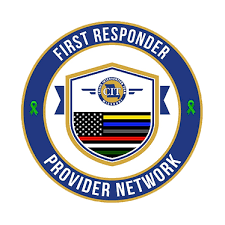
The First Responder Provider Network (FRPN) has launched a new website to help first responders access the services they need. FRPN aims to increase access to — and improve the quality of — culturally competent behavioral health care for first responders. Missouri's Crisis Intervention Team State Counsel (MO CIT) has identified a list of trained behavioral health professionals who specialize in helping law enforcement, emergency medical service (EMS) staff, firefighters, correctional staff and other first responders struggling with depression, anxiety, relationship problems, post-traumatic stress symptoms and suicidal ideation. The vetted providers are trained in trauma and have clinical and/or personal experience with a culture of professionals often stigmatized for seeking or receiving mental health treatment. The site provides easy access to providers and peer support as well as external resources such as the Cordico wellness app, a confidential app available to first responders and their loved ones.
|
Department Expands Medication-Assisted Treatment for Opiate Use Disorder
The Missouri Department of Corrections is working with Centurion and Gateway to further reduce harm for incarcerated Missourians who have opioid use disorder (OUD) by expanding medication-assisted treatment (MAT) for opioid use disorder within all Missouri Department of Corrections facilities. Currently, residents are eligible to receive MAT services within six months of release. Effective August 1, residents who have an OUD can receive medication for opioid use disorder (MOUD) services at any time during incarceration.
Things to know:
- Medication-assisted treatment (MAT) is considered the “gold standard” of care for opioid use disorder (OUD). We refer to MAT for OUD as MOUD.
- The FDA has approved three medications for treating OUD (MOUD): methadone, buprenorphine and naltrexone.
- Treatment with MOUD is combined with cognitive-behavioral therapy, psychiatric care or other forms of psychosocial support both during and after incarceration.
Department Adopts New Employee Wellness Management System
 MyCority is live!
The MyCority secure online platform, accessible 24/7, gives Department of Correction staff the ability to view key aspects of their employee health files, submit requests for FMLA, schedule appointments with select Employee Health, Wellness and Safety (EHWS) team members, or complete annual forms and self-help questionnaires.

To get started, go to https://doc.my.coritygov.com/#/login.
Select "forgot password," and enter your active directory user name (e.g., ads/abc000ad).
You'll receive an email with a link and instructions to set your password. From the home page, you can easily access all of the features.
Download the full MyCority guide »
|
New Challenge Encourages Wellness Through Community Connection
 Through Oct. 15, 2024, the Missouri Department of Corrections wellness team is encouraging staff to develop stronger community connections. Hone your community-building skills by planning or attending an event, volunteering with an organization, taking a class, starting a club, supporting locally owned businesses — you name it! Keep track of your experiences. Reflect on what you learned or gained. Record your community-connection efforts on this form, and submit it to wellness@doc.mo.gov for a chance to win a Community Challenge bundle, which includes a tote, a T-shirt and a certificate.
Using a Fishbone Diagram
A fishbone diagram is a cause-and-effect analysis tool. A team may use a fishbone diagram to identify and list all possible causes of a specific problem or effect. You can create one by drawing a horizontal line with the problem or effect written at the end, and then drawing lines coming off the central line to represent the categories or causes.
How to use the Fishbone Problem Solving Tool in 5 Steps:
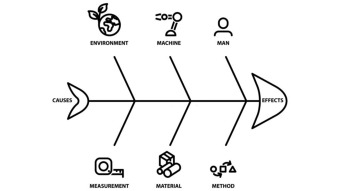
-
Assemble a team of people familiar with the work and process.
- Define the problem as simply as possible. Write the problem at the head of the fish.
- Select categories for possible causes of the problem. Typical categories may include materials, manpower, method, measurement and machine. Write each cause category on one rib of the fish.
- For each category, ask why it might be a cause of the problem. Keep going until you get to the root cause.
- Develop a corrective action that addresses your root cause or causes, and check to make sure your corrective action actually improves the process.
For more information on Operational Excellence go to: https://showmeexcellence.mo.gov/
|
Corrections Way ambassadors serve a vital role in supporting The Corrections Way (TCW), a foundation of conduct and communication built around a core of common values guiding our work. Ambassadors steer fellow staff to resources and answer questions about Corrections Way training, practice and initiatives. They keep TCW at the forefront at sites across the state. They facilitate TCW workshops, conduct leadership walks, create TCW bulletin boards, assist with planning for quality conversations, de-escalate staff tensions, send motivational emails, create TCW newsletters, and assist with planning fun activities that build morale. They are a dedicated group of people who want to create a working environment where everyone belongs — an environment built on trust, respect and rapport!
Northeast Correctional Center (NECC)

The Corrections Way Ambassadors team at Northeast Correctional Center (NECC) is taking TCW to the next level. While already established as a force for helping fellow staff members improve their communication skills, the team is now extending the principles and skill-building to residents in Dynamo, an incentive-based housing program for long-term MODOC residents who have met high standards for conduct, programming and restorative justice. Because the men in Dynamo live in an unstaffed unit, they have to work together to manage their community, navigating special projects, household chores, interpersonal relationships and any issues that arise. The Corrections Way Ambassadors are equipping them with the tools they need to succeed. Recenly ambassadors met with the Dynamo residents to teach them better ways to communicate and foster cohesion in their community. Teaching them how to have difficult conversations and flex to one another's social styles opened their eyes to what can be accomplished if they take time to understand how each person communicates.
|

Social styles served as the focus for staff at NECC as well. Ambassadors asked their teammates to complete a social styles assessment and then add their names and social styles to a bulletin board in the administration building.
The team has taken to the sidewalks too, chalking inspirational messages and cheerful drawings throughout the facility to remind their colleagues that they're part of a family. They also have installed special mirrors at the end of a corridor near the assembly room to remind staff to look professional, set a high standard and bring their best selves to work every day.
|
 Please complete this brief survey about Missouri Vocational Enterprises (MVE) products and services. Your feedback helps inform and support continuous improvement.

 The state’s business cycle runs on a fiscal year timeframe, this year from July 1, 2024, through June 30, 2025 (FY 2025). Each year we articulate our priorities to support better government in Missouri through our strategic plan. In fiscal year 2025, our mission and our goals remain constant, but our strategic initiatives continue to evolve. We are building on past years' success and adding new priorities.
Mission
Improving Lives for Safer Communities
Vision
Excellence in Corrections for a Safer Missouri
Values
We value safe work environments, a capable workforce and reduced risk and recidivism.
We value integrity and respect.
We value supportive leadership.
We value employee participation and teamwork.
|